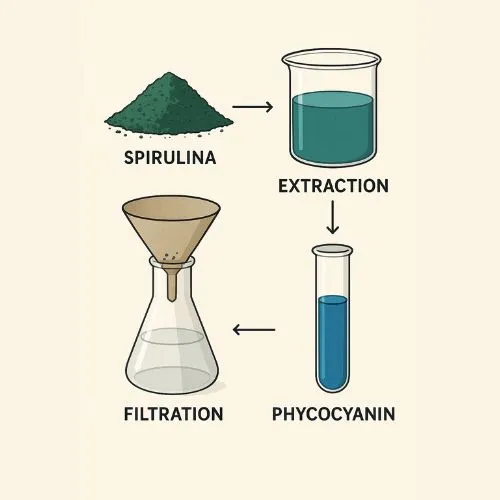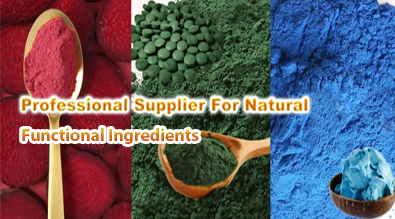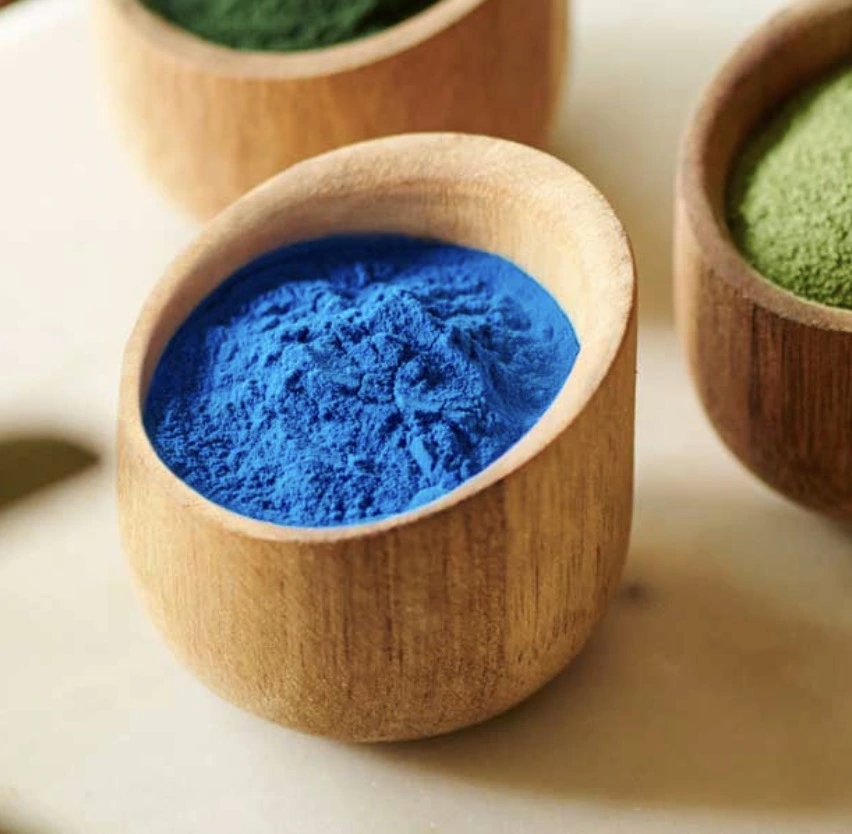What type of algae is phycocyanin from?
Phycocyanin, the brilliant blue pigment with potent health benefits, comes primarily from blue-green algae known as cyanobacteria. While several species of cyanobacteria produce phycocyanin, the most common and commercially viable source is Spirulina - specifically Arthrospira platensis and Arthrospira maxima. These remarkable microalgae have been cultivated for their nutritional properties for centuries and are now prized for their high phycocyanin content.
In this comprehensive guide, we'll explore the fascinating world of phycocyanin - from its algal origins to its extraction process and wide-ranging applications. Whether you're a health enthusiast, food manufacturer, or curious consumer, read on to discover why this vibrant blue compound is creating such a buzz in the nutrition and natural products industries.

Health benefits of phycocyanin pigment
Powerful antioxidant properties
Phycocyanin exhibits exceptional antioxidant capabilities, surpassing many common antioxidants like vitamin C in its ability to neutralize free radicals. This potent antioxidant activity helps protect cells from oxidative stress and damage. Research indicates that it can boost the body's natural antioxidant defense systems, potentially reducing the risk of chronic diseases associated with oxidative stress.
Anti-inflammatory effects
Chronic inflammation is linked to numerous health issues, from arthritis to cardiovascular disease. Phycocyanin demonstrates remarkable anti-inflammatory properties, helping to modulate the body's inflammatory response. Studies suggest it may inhibit pro-inflammatory enzymes and cytokines, offering a natural approach to managing inflammatory conditions without the side effects of conventional medications.
Neuroprotective potential
Emerging research points to phycocyanin's neuroprotective capabilities. Its antioxidant and anti-inflammatory properties may help safeguard brain cells from damage and degeneration. Some studies indicate that it could potentially slow cognitive decline and improve memory function, making it an intriguing compound for brain health and age-related cognitive issues.

How phycocyanin is extracted from spirulina?
Cultivation of spirulina
The journey of phycocyanin begins with the careful cultivation of spirulina. These cyanobacteria thrive in alkaline waters with high mineral content. Commercial spirulina farms use large, shallow ponds or bioreactors to grow the algae under controlled conditions. Optimal temperature, pH levels, and nutrient balance are maintained to encourage rapid growth and high phycocyanin production. The spirulina is then harvested, typically through filtration or centrifugation processes.
Cell disruption techniques
Once harvested, the spirulina cells must be broken open to release the phycocyanin pigment. Various cell disruption methods are employed, each with its own advantages. Ultrasonic treatment uses sound waves to shatter cell walls, while high-pressure homogenization forces the algae through a narrow valve at high pressure. Freeze-thaw cycles can also effectively rupture cell membranes. The choice of method depends on factors like efficiency, cost, and the desired purity of the final product.
Purification and concentration
After cell disruption, the phycocyanin-rich solution undergoes a series of purification steps. This often involves centrifugation to remove cell debris, followed by ultrafiltration to concentrate the phycocyanin. For higher purity grades, additional techniques like chromatography may be used. The final step typically involves carefully drying the concentrated phycocyanin solution, often through spray-drying or freeze-drying, to produce a stable powder form.

Uses of phycocyanin in food and supplements
Natural blue food coloring
Phycocyanin's vibrant blue hue makes it an invaluable natural food colorant. As consumers increasingly seek clean label products free from artificial additives, it offers a plant-based alternative to synthetic blue dyes. It's used in a wide array of food and beverage applications, from confectionery and dairy products to baked goods and beverages. Its pH-dependent color-shifting properties also allow for the creation of various shades of green and purple when combined with other natural pigments.
Nutritional supplements
The health-promoting properties of phycocyanin have led to its increasing popularity as a dietary supplement. Available in capsule, powder, or liquid form, phycocyanin supplements are marketed for their antioxidant, anti-inflammatory, and immune-boosting potential. Some formulations combine phycocyanin with other nutrients from spirulina for a more comprehensive nutritional profile. As research into phycocyanin's benefits continues to expand, so does its presence in the nutraceutical market.
Functional food ingredients
Beyond its role as a colorant, phycocyanin is gaining traction as a functional food ingredient. Food manufacturers are incorporating it into products to enhance nutritional value and appeal to health-conscious consumers. From protein bars and smoothie powders to fortified beverages and snack foods, phycocyanin is finding its way into a diverse range of functional food applications. Its water-solubility and stability in certain pH ranges make it a versatile ingredient for food fortification.

Conclusion
Phycocyanin, derived primarily from spirulina algae, stands out as a remarkable compound with diverse applications and potential health benefits. From its potent antioxidant properties to its use as a natural blue food coloring, it continues to captivate researchers and industry professionals alike. As extraction techniques improve and new applications emerge, this blue-green algae pigment is poised to play an increasingly significant role in the fields of nutrition, food technology, and health supplements.
Are you interested in harnessing the power of phycocyanin for your products? At Yangge Biotech Co., Ltd., we specialize in high-quality phycocyanin extracts derived from carefully cultivated spirulina. Our team of experts is dedicated to providing innovative, natural solutions for the food, beverage, and supplement industries. To learn more about our phycocyanin supplements or to discuss how we can meet your specific needs, please don't hesitate to contact us at info@yanggebiotech.com.
FAQ
Q: Can we get some samples to test before purchasing?
A: Of course, we can provide free samples of 20 to 100 grams, but the shipping cost is at the customer's expense. The shipping cost can be deducted from the next order, or the samples can be sent through your courier account.
Q: Do your products have relevant certifications?
A: Yes, our products are certified for HALAL, ISO, HACCP, Kosher, and other certifications.
Q: What is the minimum order quantity (MOQ)?
A: Small batches of samples can be customized according to your requirements.
Q: Do you offer OEM and ODM services? Can the formula be customized based on our own?
A: Of course, we provide ODM and OEM services to many customers. Our product range includes softgels, capsules, tablets, sachets, granules, and private label services. Simply contact us and let us know your requirements. Our experienced R&D team can also develop new products with specific formulas.
Please contact us to design your own branded products.
Q: How do you handle quality complaints?
A: First, we have a comprehensive quality control SOP. We provide authoritative third-party inspection reports for almost all products before shipment to minimize the possibility of quality issues. Second, we have a comprehensive return and exchange procedure. If there is a genuine quality dispute, we will strictly follow the SOP.
Q: How do you ship? How long does delivery take?
A: For small orders, we typically use DHL, UPS, EMS, FedEx, or TNT. Delivery typically takes 3-7 days. We also offer air and sea freight services. We have a strong freight forwarding team and can provide you with a one-stop service, including DDP and DDU.
Q: What are your payment terms?
A: 100% prepayment, payable by T/T, Western Union, MoneyGram, or PayPal.
Q: What is the shelf life of your products?
A: 2 years with proper storage.
Q: Is the packaging environmentally friendly?
A: We attach great importance to environmental protection and are constantly improving our product packaging. Some products are packaged in recyclable paper. Packaging materials are carefully selected to ensure product safety during transportation and storage, and to minimize environmental impact. We are committed to achieving a balance between environmental friendliness and practicality in our product packaging, and to contributing to sustainable development.
References
1. Eriksen, N. T. (2008). Production of phycocyanin—a pigment with applications in biology, biotechnology, foods and medicine. Applied Microbiology and Biotechnology, 80(1), 1-14.
2. Fernández-Rojas, B., Hernández-Juárez, J., & Pedraza-Chaverri, J. (2014). Nutraceutical properties of phycocyanin. Journal of Functional Foods, 11, 375-392.
3. Kuddus, M., Singh, P., Thomas, G., & Al-Hazimi, A. (2013). Recent developments in production and biotechnological applications of C-phycocyanin. BioMed Research International, 2013, 742859.
4. Martelli, G., Folli, C., Visai, L., Daglia, M., & Ferrari, D. (2014). Thermal stability improvement of blue colorant C-Phycocyanin from Spirulina platensis for food industry applications. Process Biochemistry, 49(1), 154-159.
5. Sonani, R. R., Rastogi, R. P., Patel, R., & Madamwar, D. (2016). Recent advances in production, purification and applications of phycobiliproteins. World Journal of Biological Chemistry, 7(1), 100-109.

Based on your location and order quantity, you will have the opportunity to receive a limited time free shipping promotion!

Who we are


